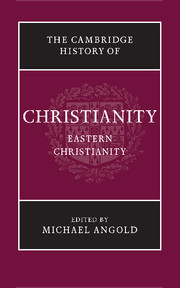Book contents
- Frontmatter
- PART I THE ECUMENICAL PATRIARCHATE
- PART II THE RUSSIAN CHURCH
- 11 Russian piety and Orthodox culture 1380–1589
- 12 Art and liturgy in Russia: Rublev and his successors
- 13 Eastern Orthodoxy in Russia and Ukraine in the age of the Counter-Reformation
- 14 The Russian Orthodox Church in imperial Russia 1721–1917
- 15 Russian piety and culture from Peter the Great to 1917
- PART III EASTERN CHRISTIANITIES
- PART IV THE MODERN WORLD
- Bibliography
- Index
- References
12 - Art and liturgy in Russia: Rublev and his successors
from PART II - THE RUSSIAN CHURCH
Published online by Cambridge University Press: 28 March 2008
- Frontmatter
- PART I THE ECUMENICAL PATRIARCHATE
- PART II THE RUSSIAN CHURCH
- 11 Russian piety and Orthodox culture 1380–1589
- 12 Art and liturgy in Russia: Rublev and his successors
- 13 Eastern Orthodoxy in Russia and Ukraine in the age of the Counter-Reformation
- 14 The Russian Orthodox Church in imperial Russia 1721–1917
- 15 Russian piety and culture from Peter the Great to 1917
- PART III EASTERN CHRISTIANITIES
- PART IV THE MODERN WORLD
- Bibliography
- Index
- References
Summary
In the thirteenth century large parts of Russia fell to the Mongol invaders. The initial impact on religious life and art was devastating. Priests and monks were slain, churches and icons were burned, cult objects made of precious metals and gems were looted. The anonymous author of The Tale of the Destruction of Riazan, the first city to be attacked in 1237, recounted:
They burnt the whole city of Riazan with all its renowned beauty and wealth and seized the relatives of the princes of Kiev and Chernigov. They destroyed God’s churches and spilt much blood on the sacred altars. Not one person was left alive in the city, all had died and supped from the same cup of death. And all this came about for our sins.
Even if we make allowances for the rhetorical insistence upon complete annihilation, the losses were devastating. The sheer number of Orthodox Christians who perished at the hands of pagans, together with the belief that God had inflicted ruin on Russia as a punishment ‘for our sins’, left the survivors and their descendants with the imperative of praying for the souls of the dead and the salvation of the living. In this disaster lay the seeds of a religious revival that has been described as ‘the flowering of Russian holiness’.
- Type
- Chapter
- Information
- The Cambridge History of Christianity , pp. 276 - 301Publisher: Cambridge University PressPrint publication year: 2006



